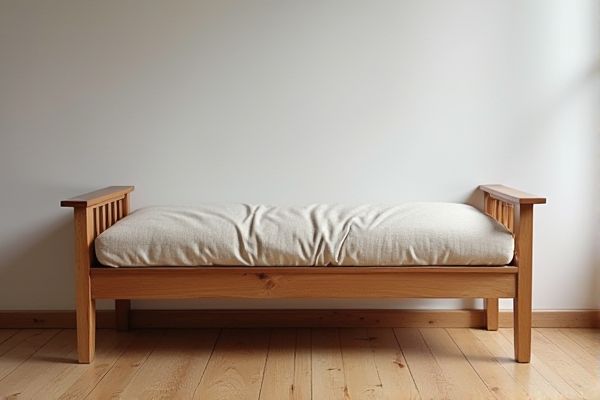
A slatted bench offers better drainage and ventilation, making it ideal for outdoor use and preventing water accumulation, while a solid seat bench provides a more uniform and comfortable seating surface suitable for indoor or covered areas. Explore the rest of the article to discover which bench style best fits your needs and enhances Your space.
Table of Comparison
| Feature | Slatted Bench | Solid Seat Bench |
|---|---|---|
| Material | Wood or metal slats spaced apart | Single solid wood or metal piece |
| Comfort | Better ventilation, cooler seating | Smoother, consistent surface |
| Water Drainage | Excellent drainage due to gaps | Poor drainage, water can pool |
| Durability | Requires regular maintenance; gaps reduce rot risk | More prone to cracking, needs sealing |
| Aesthetic | Modern, airy look | Classic, solid appearance |
| Weight | Lighter due to spaced slats | Heavier due to solid construction |
| Cost | Generally more affordable | Typically higher cost |
| Maintenance | Easy to clean gaps; needs regular finish | Harder to clean; sealing required |
Introduction to Slatted Benches and Solid Seat Benches
Slatted benches feature individual wooden or metal slats spaced evenly to promote airflow and quick drying, making them ideal for outdoor environments. Solid seat benches offer a continuous flat surface, providing a sturdier and more comfortable sitting experience suitable for both indoor and outdoor use. Material choices and design focus differ, with slatted benches emphasizing ventilation and water drainage, while solid seat benches prioritize durability and comfort.
Design Overview: Slatted vs. Solid Seat Benches
Slatted benches feature a series of narrow, spaced wooden or metal slats that offer enhanced airflow and water drainage, making them ideal for outdoor use and wet environments. Solid seat benches provide a continuous surface that delivers a sleek, modern aesthetic and greater support, often preferred for indoor settings or areas requiring a clean, minimalist look. Understanding the design differences helps you choose a bench that best suits your comfort needs and environmental conditions.
Material Differences and Durability
Slatted benches are typically constructed with spaced wooden or metal slats that allow for better airflow and water drainage, which enhances their durability in outdoor settings by preventing moisture buildup and reducing the risk of rot or rust. Solid seat benches, often made from a single piece of wood, metal, or composite material, provide a sturdier and more comfortable sitting surface but may require more maintenance to protect against warping or water damage over time. Choosing between the two depends on your desired balance between durability, comfort, and maintenance needs for your outdoor or indoor space.
Comfort and Ergonomics Comparison
Slatted benches typically provide better ventilation and water drainage, enhancing comfort during extended use, while solid seat benches offer a more stable and uniform surface for seating. Ergonomically, slatted designs may contour slightly to body shape and reduce heat buildup, but solid benches often deliver stronger support and durability. Your choice should balance airflow needs with desired seat firmness to optimize overall comfort and posture support.
Ventilation and Moisture Management
Slatted benches provide superior ventilation by allowing air to circulate freely through the gaps between slats, reducing heat buildup and minimizing moisture retention. This design helps prevent mold and mildew growth by promoting faster drying after exposure to rain or sweat. In contrast, solid seat benches tend to trap moisture on the surface, increasing the risk of water damage and discomfort due to poor airflow.
Maintenance and Cleaning Requirements
Slatted benches require less maintenance as their gaps allow dirt and water to fall through, reducing the risk of mold and mildew buildup, making cleaning easier and faster. Solid seat benches tend to accumulate debris and moisture on the surface, necessitating more frequent wiping and thorough cleaning to prevent stains and deterioration. Regular maintenance of both types, including sealing or treating the wood, is essential to prolong their durability and aesthetic appeal.
Aesthetics and Style Considerations
Slatted benches offer a sleek, airy appearance with visible gaps that create a sense of lightness and texture, ideal for modern or rustic outdoor spaces. Solid seat benches provide a smooth, continuous surface that conveys a more traditional, robust look suitable for classic or formal settings. Choosing between the two depends on the desired visual impact and the surrounding design elements in a space.
Outdoor vs. Indoor Suitability
Slatted benches offer excellent outdoor suitability due to their ability to drain water quickly, preventing pooling and reducing the risk of weather-related damage or mold growth. Solid seat benches are better suited for indoor environments where exposure to moisture and temperature fluctuations is minimal, providing a smoother, more comfortable seating experience. Choosing the right bench depends on your specific location and intended use to ensure durability and comfort.
Cost and Value Analysis
Slatted benches typically cost less due to their minimal material usage and simpler construction, offering excellent value for budget-conscious buyers. Solid seat benches, made from a single piece of wood or thick composite, often carry a higher price but provide superior durability and a more refined aesthetic. Your choice between slatted and solid seat benches should balance initial cost with long-term value, considering maintenance and longevity.
Choosing the Right Bench for Your Space
Slatted benches offer excellent ventilation and water drainage, making them ideal for outdoor spaces prone to moisture or heat. Solid seat benches provide a more uniform seating surface, enhancing comfort and durability in indoor or covered areas. Selecting the right bench depends on factors such as exposure to weather, usage frequency, and desired aesthetic for your specific environment.
 homyna.com
homyna.com